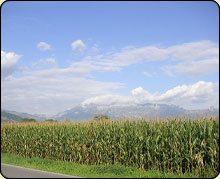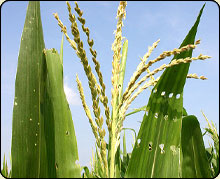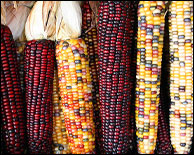|
Hunting, Recreational, Fishing, Investment Land For Sale in Mississippi, Delta, Ranch, Farm, Timber Land for Sale In Mississippi
|
Welcome
Thacker Mountain Lodge Land and Property Division offers corn acreage, corn farms, Mississippi corn farms, Delta corn farms, Mississippi corn farms for sale and Mississippi Delta corn farms for sale. Thacker Mountain Lodge also offers, for sale Premium Mississippi, Delta, and Mid-South, land, ranches, farms, investment, recreational, timberland, and commercial property located in the river delta. This area is referred to as the Mississippi River corn Delta area. Corn is the most widely grown crop in the Americas (332 million metric tons annually in the United States alone). Hybrid corn, due to its high grain yield as a result of heterosis ("hybrid vigor"), is preferred by farmers over conventional varieties. While some corn varieties grow up to 7 metres (23 ft) tall, most commercially grown corn has been bred for a standardized height of 2.5 metres (8 ft). Sweet corn is usually shorter than field-corn varieties.
|

 Corn Allergy
Corn Allergy
Corn contains lipid transfer protein, an undigestable protein which survives cooking. This protein has been linked to a rare and understudied allergy to corn in humans. The allergic reaction can cause skin rash, swelling or itching of mucus membranes, diarrhea, vomiting, asthma and, in severe cases, anaphylactic shock. It has been noted that those with corn allergy almost always have peach allergy as well. It is unclear how common this allergy is in the general populace.
|

 Corn as a Food
Corn as a Food
Corn and cornmeal (corn flour) constitutes a staple food in many regions of the world. Corn meal is made into a thick porridge in many cultures: from the polenta of Italy, the angu of Brazil, the mămăligă of Romania, to mush in the U.S. or the food called sadza, nshima, ugali, and mealie pap in Africa. Corn meal is also used as a replacement for wheat flour, to make cornbread and other baked products. Masa (cornmeal treated with lime water) is the main ingredient for tortillas, atole and many other dishes of Mexican food. Popcorn is kernels of certain varieties that explode when heated, forming fluffy pieces that are eaten as a snack. Chicha and "chicha morada" (purple chicha) are drinks made usually from particular types of corn. The first one is fermented and alcoholic, the second is a soft drink commonly drunk in Peru.
|

 Thacker Mountain Lodge
Thacker Mountain Lodge
Thacker Mountain Lodge Timber and land, Property division offers hunting and fishing property for sale. If your investment property group wants to buy mid-south hunting property, Mississippi hunting land for sale, Mississippi homes, Mississippi farms, Mississippi ranches and hunting property, Mississippi hunting property, mid-sized hunting property, or Mississippi recreational hunting property, Thacker Mountain Lodge Timber and land Property Division can help.
Call The Thacker Mountain Lodge Land and Timber Property Division today or email us at
properties@thackermountainlodge.com
|
|
|
Corn Farms for Sale, Mississippi Corn Farms, Mississippi Delta Corn Farms, Corn Farms
|
Corn is a cereal grain domesticated in Mesoamerica and subsequently spread throughout the American continents. After European contact with the Americas in the late 15th and early 16th centuries, corn spread to the rest of the world. Thacker Mountain Lodge Land and Property Division Offers corn acreage, corn farms, Mississippi corn farms, Delta corn farms, Mississippi corn farms for sale and Mississippi Delta corn farms for sale.

|
|
|
In 2005, research by the USDA Forest Service indicated that the rise in corn cultivation 500 to 1,000 years ago in what is now the southeastern United States contributed to the decline of freshwater mussels, which are very sensitive to environmental changes.
|
|

|
Need Mississippi hunting leases, mid-south hunting and fishing spots, Mississippi real estate, homes, farms, ranches, and Mississippi deer hunting, deer hunting land for sale in Mississippi, Thacker Mountain Lodge land and timber property division can supply what you need.
|
|
|

 Corn Physiology Corn Physiology
Corn stems superficially resemble bamboo canes and the internodes can reach 20–30 centimetres (8–12 in). Corn has a very distinct growth form; the lower leaves being like broad flags, 50–100 centimetres long and 5–10 centimetres wide (2–4 ft by 2–4 in); the stems are erect, conventionally 2–3 metres (7–10 ft) in height, with many nodes, casting off flag-leaves at every node. Under these leaves and close to the stem grow the ears. They grow about 3 milimetres a day.
The ears are female inflorescences, tightly covered over by several layers of leaves, and so closed-in by them to the stem that they do not show themselves easily until the emergence of the pale yellow silks from the leaf whorl at the end of the ear. The silks are elongated stigmas that look like tufts of hair, at first green, and later red or yellow. Plantings for silage are even denser, and achieve an even lower percentage of ears and more plant matter. Certain varieties of corn have been bred to produce many additional developed ears, and these are the source of the "baby corn" that is used as a vegetable in Asian cuisine.
Corn is a facultative long-night plant and flowers in a certain number of growing degree days > 50 °F (10 °C) in the environment to which it is adapted. The magnitude of the influence that long nights have on the number of days that must pass before corn flowers is genetically prescribed and regulated by the phytochrome system. Photoperiodicity can be eccentric in tropical cultivars, while the long days characteristic of higher latitudes allow the plants to grow so tall that they do not have enough time to produce seed before being killed by frost. These attributes, however, may prove useful in using tropical corn for biofuels.
The apex of the stem ends in the tassel, an inflorescence of male flowers. Each silk may become pollinated to produce one kernel of corn. Young ears can be consumed raw, with the cob and silk, but as the plant matures (usually during the summer months) the cob becomes tougher and the silk dries to inedibility. By the end of the growing season, the kernels dry out and become difficult to chew without cooking them tender first in boiling water. Modern farming techniques in developed countries usually rely on dense planting, which produces one large ear per stalk.

|

Corn Seeds
The kernel of corn has a pericarp of the fruit fused with the seed coat, typical of the grasses. It is close to a multiple fruit in structure, except that the individual fruits (the kernels) never fuse into a single mass. The grains are about the size of peas, and adhere in regular rows round a white pithy substance, which forms the ear. An ear contains from 200 to 400 kernels, and is from 10–25 centimetres (4–10 inches) in length. They are of various colors: blackish, bluish-gray, red, white and yellow. When ground into flour, corn yields more flour, with much less bran, than wheat does. However, it lacks the protein gluten of wheat and, therefore, makes baked goods with poor rising capability and coherence.
A genetic variation that accumulates more sugar and less starch in the ear is consumed as a vegetable and is called sweet corn.
Immature corn shoots accumulate a powerful antibiotic substance, DIMBOA (2,4-dihydroxy-7-methoxy-1,4-benzoxazin-3-one). DIMBOA is a member of a group of hydroxamic acids (also known as benzoxazinoids) that serve as a natural defense against a wide range of pests including insects, pathogenic fungi and bacteria. DIMBOA is also found in related grasses, particularly wheat. A corn mutant (bx) lacking DIMBOA is highly susceptible to be attacked by aphids and fungi. DIMBOA is also responsible for the relative resistance of immature corn to the European corn borer (family Crambidae). As corn matures, DIMBOA levels and resistance to the corn borer decline.
Due to its shallow roots of only one to two inches deep, Corn is susceptible to droughts, intolerant of nutrient-deficient soils, and prone to be uprooted by severe winds.

|

Corn Genetics
Corn has 10 chromosomes (n=10). The combined length of the chromosomes is 1500 cM. Some of the corn chromosomes have what are known as "chromosomal knobs": highly repetitive heterochromatic domains that stain darkly. Individual knobs are polymorphic among strains of both corn and teosinte. Barbara McClintock used these knob markers to prove her transposon theory of "jumping genes", for which she won the 1983 Nobel Prize in Physiology or Medicine. corn is still an important model organism for genetics and developmental biology today. Thacker Mountain Lodge Land and Property Division Offers corn acreage, corn farms, Mississippi corn farms, Delta corn farms, Mississippi corn farms for sale and Mississippi Delta corn farms for sale.
There is a stock center of corn mutants, The Maize Genetics Cooperation Stock Center, funded by the USDA Agricultural Research Service and located in the Department of Crop Sciences at the University of Illinois at Urbana-Champaign. The total collection has nearly 80,000 samples. The bulk of the collection consists of several hundred named genes, plus additional gene combinations and other heritable variants. There are about 1000 chromosomal aberrations (e.g., translocations and inversions) and stocks with abnormal chromosome numbers (e.g., tetraploids). Genetic data describing the corn mutant stocks as well as myriad other data about corn genetics can be accessed at MaizeGDB, the Maize Genetics and Genomics Database.
In 2005, the U.S. National Science Foundation (NSF), Department of Agriculture (USDA) and the Department of Energy (DOE) formed a consortium to sequence the corn genome. The resulting DNA sequence data will be deposited immediately into GenBank, a public repository for genome-sequence data. Sequencing the corn genome has been considered difficult because of its large size and complex genetic arrangements. The genome has 50,000–60,000 genes scattered among the 2.5 billion bases—molecules that form DNA—that make up its 10 chromosomes. (By comparison, the human genome contains about 2.9 billion bases and 26,000 genes.)On February 26, 2008, researchers announced that they had sequenced the entire genome of corn.

|

Thacker Mountain Lodge Timber and land, Property division offers hunting and fishing property for sale. If your investment property group wants to buy mid-south hunting property, Mississippi hunting land for sale, Mississippi homes, Mississippi farms, Mississippi ranches and hunting property, Mississippi hunting property, mid-sized hunting property, or Mississippi recreational hunting property, Thacker Mountain Lodge Timber and land Property Division can help.
Need Mississippi hunting leases, mid-south hunting and fishing spots, Mississippi real estate, homes, farms, ranches, and Mississippi deer hunting, deer hunting land for sale in Mississippi, Thacker Mountain Lodge land and timber property division can supply what you need.
Call The Thacker Mountain Lodge Land and Timber Property Division today or email us at
properties@thackermountainlodge.com

|
|
|
|